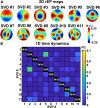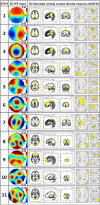Combination of Group Singular Value Decomposition and eLORETA Identifies Human EEG Networks and Responses to Transcranial Photobiomodulation
- PMID: 35620152
- PMCID: PMC9127055
- DOI: 10.3389/fnhum.2022.853909
Combination of Group Singular Value Decomposition and eLORETA Identifies Human EEG Networks and Responses to Transcranial Photobiomodulation
Abstract
Transcranial Photobiomodulation (tPBM) has demonstrated its ability to alter electrophysiological activity in the human brain. However, it is unclear how tPBM modulates brain electroencephalogram (EEG) networks and is related to human cognition. In this study, we recorded 64-channel EEG from 44 healthy humans before, during, and after 8-min, right-forehead, 1,064-nm tPBM or sham stimulation with an irradiance of 257 mW/cm2. In data processing, a novel methodology by combining group singular value decomposition (gSVD) with the exact low-resolution brain electromagnetic tomography (eLORETA) was implemented and performed on the 64-channel noise-free EEG time series. The gSVD+eLORETA algorithm produced 11 gSVD-derived principal components (PCs) projected in the 2D sensor and 3D source domain/space. These 11 PCs took more than 70% weight of the entire EEG signals and were justified as 11 EEG brain networks. Finally, baseline-normalized power changes of each EEG brain network in each EEG frequency band (delta, theta, alpha, beta and gamma) were quantified during the first 4-min, second 4-min, and post tPBM/sham periods, followed by comparisons of frequency-specific power changes between tPBM and sham conditions. Our results showed that tPBM-induced increases in alpha powers occurred at default mode network, executive control network, frontal parietal network and lateral visual network. Moreover, the ability to decompose EEG signals into individual, independent brain networks facilitated to better visualize significant decreases in gamma power by tPBM. Many similarities were found between the cortical locations of SVD-revealed EEG networks and fMRI-identified resting-state networks. This consistency may shed light on mechanistic associations between tPBM-modulated brain networks and improved cognition outcomes.
Keywords: default mode network; eLORETA; executive control network; frontal parietal network; singular value decomposition; transcranial photobiomodulation.
Copyright © 2022 Wang, Wanniarachchi, Wu and Liu.
Conflict of interest statement
The authors declare that the research was conducted in the absence of any commercial or financial relationships that could be construed as a potential conflict of interest. The handling editor FG-L declared a past co-authorship with the authors.
Figures







Similar articles
-
Simultaneous MEG and EEG source imaging of electrophysiological activity in response to acute transcranial photobiomodulation.Front Neurosci. 2024 May 16;18:1368172. doi: 10.3389/fnins.2024.1368172. eCollection 2024. Front Neurosci. 2024. PMID: 38817913 Free PMC article.
-
Repeated Transcranial Photobiomodulation with Light-Emitting Diodes Improves Psychomotor Vigilance and EEG Networks of the Human Brain.Bioengineering (Basel). 2023 Sep 5;10(9):1043. doi: 10.3390/bioengineering10091043. Bioengineering (Basel). 2023. PMID: 37760145 Free PMC article.
-
Site- and electroencephalogram-frequency-specific effects of 800-nm prefrontal transcranial photobiomodulation on electroencephalogram global network topology in young adults.Neurophotonics. 2025 Jan;12(1):015011. doi: 10.1117/1.NPh.12.1.015011. Epub 2025 Feb 27. Neurophotonics. 2025. PMID: 40018415 Free PMC article.
-
Effect of transcranial photobiomodulation on electrophysiological activity of brain in healthy individuals: A scoping review.J Clin Neurosci. 2023 Nov;117:156-167. doi: 10.1016/j.jocn.2023.09.029. Epub 2023 Oct 10. J Clin Neurosci. 2023. PMID: 37826867
-
Can transcranial photobiomodulation improve cognitive function in TBI patients? A systematic review.Front Psychol. 2024 Jun 17;15:1378570. doi: 10.3389/fpsyg.2024.1378570. eCollection 2024. Front Psychol. 2024. PMID: 38952831 Free PMC article.
Cited by
-
Simultaneous MEG and EEG source imaging of electrophysiological activity in response to acute transcranial photobiomodulation.Front Neurosci. 2024 May 16;18:1368172. doi: 10.3389/fnins.2024.1368172. eCollection 2024. Front Neurosci. 2024. PMID: 38817913 Free PMC article.
-
Directed physiological networks in the human prefrontal cortex at rest and post transcranial photobiomodulation.Res Sq [Preprint]. 2023 Oct 6:rs.3.rs-3393702. doi: 10.21203/rs.3.rs-3393702/v1. Res Sq. 2023. Update in: Sci Rep. 2024 May 3;14(1):10242. doi: 10.1038/s41598-024-59879-7. PMID: 37886539 Free PMC article. Updated. Preprint.
-
Quantitative simulation of near-infrared light treatment for Alzheimer's disease using patient-individualized optical-parametric phantoms.Neurophotonics. 2025 Jan;12(1):015010. doi: 10.1117/1.NPh.12.1.015010. Epub 2025 Feb 18. Neurophotonics. 2025. PMID: 39968373 Free PMC article.
-
Repeated Transcranial Photobiomodulation with Light-Emitting Diodes Improves Psychomotor Vigilance and EEG Networks of the Human Brain.Bioengineering (Basel). 2023 Sep 5;10(9):1043. doi: 10.3390/bioengineering10091043. Bioengineering (Basel). 2023. PMID: 37760145 Free PMC article.
-
Site- and electroencephalogram-frequency-specific effects of 800-nm prefrontal transcranial photobiomodulation on electroencephalogram global network topology in young adults.Neurophotonics. 2025 Jan;12(1):015011. doi: 10.1117/1.NPh.12.1.015011. Epub 2025 Feb 27. Neurophotonics. 2025. PMID: 40018415 Free PMC article.
References
Grants and funding
LinkOut - more resources
Full Text Sources

